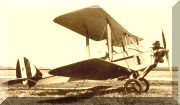Caproni Ca.100
| Ca.100 | |
|---|---|
 |
|
| Caproni Ca.100 trainer | |
| Role | Trainer |
| Manufacturer | Caproni |
| First flight | 1928 |
| Primary user | Regia Aeronautica |
| Number built | c.700 |
The Caproni Ca.100 was the standard trainer aircraft of the Regia Aeronautica in the 1930s. Large numbers of this tandem, two-seat, inverted sesquiplane were built, powered by different engines.
The Ca.100 (nicknamed Caproncino, little Caproni), was based on the de Havilland DH.60 Moth, for which Caproni had a production licence. They revised the wings to create an inverted sesquiplane configuration and also redesigned the tailplane. Otherwise, its wings followed those of the Moth in having no sweep or stagger. It was a wooden-framed, fabric-covered single-engine aircraft with a square section fuselage built around four longerons, with tandem open cockpits. It had a fixed, conventional undercarriage. Fuel was carried, Moth style, in a streamlined tank on the centre section of the upper wing. It first flew in late 1928, piloted by Domenico Antonini, at Milan-Taliedo.
Ca.100s were powered by a variety of engines. The most common of these were the 85 kW (115 hp) Isotta Fraschini Asso 80R and the 108 kW (145 hp) Colombo S.63, both six-cylinder air-cooled inline engines, and the uncowled 63 kW (85 hp) Fiat A.50 and 104 kW (140 hp) A.54 seven-cylinder radials. Other engines in the 60-100 kW (80-135 hp) range included the Walter NZ-85, Farini T.58, Fiat A.53, Fiat A.60 radials and the inline Colombo S.53, Cirrus Major, de Havilland Gipsy, de Havilland Gipsy Major engines.
The Regia Aeronautica received two prototype and 675 production Ca.100s, built by Bergamasche, Breda, C.N.A. and Macchi as well as Caproni. 30 of the Macchi-built examples were fitted with floats and designated Ca.100 Idro. The Ca.100s were mostly used as primary trainers, though some undertook liaison work.
...
Wikipedia
